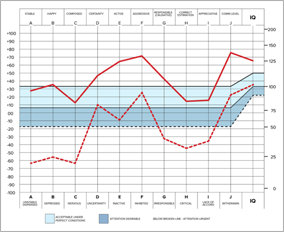Auditing gains which a person feels subjectively can also be shown objectively through testing during the course of an auditing program.
Numerous tests are used to measure the preclear’s ability prior to starting an auditing program and also provide a prediction of how much auditing it may take to achieve a certain result with the preclear. When retested afterwards, the improvements he experiences personally can be plotted on a graph, which validates his gains.
These objective measures of a person’s improvement fly in the face of commonly held beliefs. Prior to Dianetics, psychiatry and psychology were adamant in their assertion that a person’s ability and intelligence could not be changed. Their pronouncements were disproven in the face of study after study wherein people showed dramatic increases in both areas after auditing.
One routine test, adapted by the Church itself, is known as the Oxford Capacity Analysis (OCA) which is designed to graphically represent ten different personality traits. These rise markedly in auditing, reflecting the preclear’s gains. Preclears report being calmer, more stable, more energetic and more outgoing as a direct result of auditing and scores on the OCA furnish corroborative data.
Aptitude tests are also a reliable indicator of auditing results. Improvements in aptitude test scores correlate with a decrease in propensity toward accidents. Many other tests are available that measure coordination and perceptions such as vision, hearing, colorblindness, balance and so on. These functions also improve as a result of auditing.
Naturally, individual progress is variable since it is largely influenced by the preclear’s dedication and the frequency of sessions. Therefore, clearly defined rates of improvement are impossible to establish and the Church makes no claims or guarantees of the gains someone will make in auditing. Church staff, however, have seen so many remarkable improvements in parishioners that they expect such results as a matter of course.











